After winning the prestigious, three-year National Science Foundation Research Experiences for Undergraduates site award grant in 2019, MTSU hosted undergraduates from across the country for eight weeks of workshops, courses, travel, research and experiments from June 7 to July 30.
The students, selected after a rigorous application process, were part of one of two research groups made up of eight members each: the science-based chemistry research utilizing X-ray methods group, also known as CRUX, and the math-based computational modeling and simulation in applied sciences group, also known as COMS.

Undergraduate students from around the country who earned the National Science Foundation Research Experience for Undergraduates grant perform research while visiting Middle Tennessee State University this summer. From left are students Alex LaVerde and Carina Vazquez, MTSU physics and astronomy professor William Robertson and student Jennifer Lopez, who worked on math-based research like this acoustic ring resonance project on July 28, 2021, in the Wiser-Patten Science building. (MTSU photo by J. Intintoli)
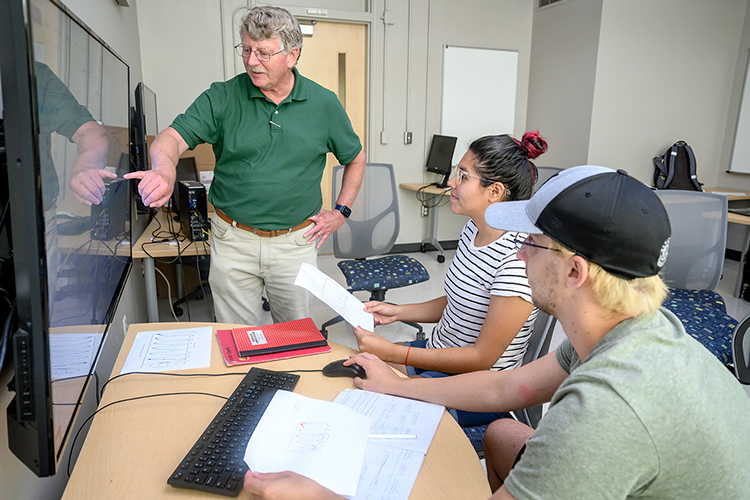
Undergraduate students who earned the National Science Foundation Research Experience for Undergraduates grant, including Alex LaVerde, right, from the University of Alabama and Jennifer Lopez, center, from Ginnell College, work on research with William Robertson, MTSU physics and astronomy professor, in the Wiser-Patten Science building on July 28, 2021. Middle Tennessee State University hosted the undergraduate students from around the country for eight weeks of workshops, courses, travel, research and experiments. (MTSU photo by J. Intintoli)
MTSU’s Rachel Leander, an associate math professor who worked with the COMS group, said the grant, known within academia as the NSF REU, has been highly beneficial for the university and faculty involved.
“It furthers our greater educational mission,” Leander said. “Here we have the opportunity to train students in this fast-growing and high-need area of computational science and prepare them for jobs in that field. It also helps … by publicizing our research programs. That helps us to attract more talented students and also to earn public support and funding.
“It’s a great opportunity for (faculty) to further our research because we have the opportunity to work with these highly-talented and hardworking students over eight weeks in the summer. That furthers our research program and also is a great, rewarding mentoring opportunity.”
The computational science cohort
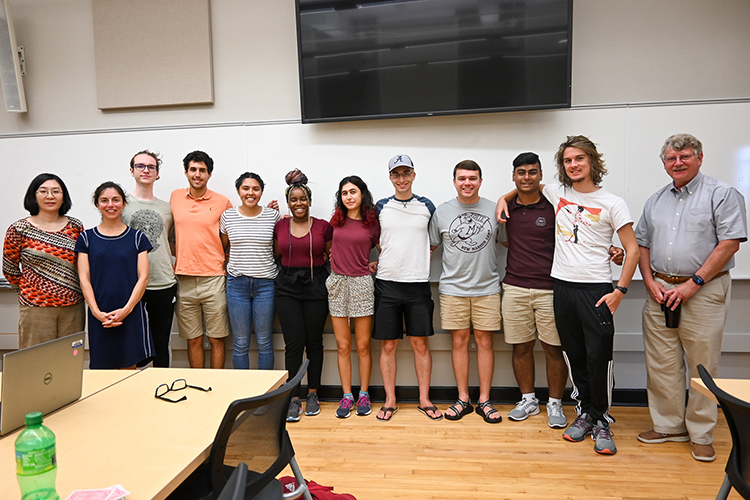
Middle Tennessee State University faculty and computational science undergraduate students from around the country who earned the National Science Foundation Research Experience for Undergraduates grant meet for a workshop on research ethics on July 20, 2021, at MTSU’s Wiser-Patten Science building. Standing, from left, are Dr. Wandi Ding, Rachel Leander, Nicolas Kaszynski, Shawheen Naderi, Jennifer Lopez, Allis Royer, Adira Cohen, Alex LaVerde, Daniel Bond, Shivam Patel, Joshua Miller and Dr. William Robertson. (MTSU photo by Stephanie Barrette)
Students Daniel Bond, Adira Cohen, Alex LaVerde, Jennifer Lopez, Joshua Miller, Shawheen Naderi, Allis Royer and Shivam Patel, who is also an MTSU biology student, made up the COMS cohort.
MTSU’s Wandi Ding, math professor; William Robertson, physics and astronomy professor; and Joshua Phillips, associate computer science professor, rounded out the faculty working with the COMS students.
Faculty used their combined expertise to help the students develop practical research skills, computer programming skills, high-performance computing skills and mathematical modeling skills.
MTSU student Patel credited professor Leander with informing him about the REU opportunity.
“When I talked to her, she was very supportive to me,” he said. “She helped me with everything. It was her who got me into the program.”
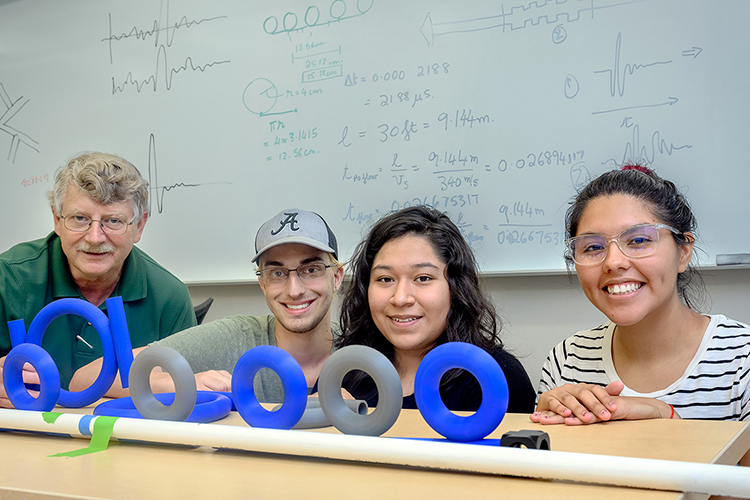
William Robertson, Middle Tennessee State University physics and astronomy professor, far left, works with undergraduate students from around the country as part of the National Science Foundation Research Experience for Undergraduates grant. Students Alex LaVerde, center left, Carina Vazquez and Jennifer Lopez researched acoustic ring resonance in the Wiser-Patten Science building on July 28, 2021. (MTSU photo by J. Intintoli)
He said the COMS program had many benefits, especially because it was outside his normal area of study, biology, which allowed him to learn about math and computational science.
“Learning how to code,” he said, was the biggest benefit along with learning how to work with students from other disciplines and conduct research.
The program was not all work and no play. Students enjoyed a day at Nashville Shores and capped off the eight weeks with a celebration and presentation of their research at the Science Building on campus.
The chemistry cohort

Middle Tennessee State University faculty Andrienne Friedli, far left, and Justin Miller, far right, join a cohort of chemistry undergraduate students from around the country, who earned the National Science Foundation Research Experience for Undergraduates grant, for a visit to the HudsonAlpha Institute for Biotechnology in Huntsville, Ala., on June 25, 2021. (Photo courtesy of Adrienne Friedli)
Garrett Trimble, Jake Collins, William Nese, Lindsey Foote, Dakota Cook, Noel Castillo, Nicole Chavarria and Nirvana Almada, who is starting at MTSU as a graduate student this fall, were part of the chemistry student group and the first chemistry student cohort allowed on campus following the COVID limitations of summer 2020.
The program began online to allow students to become acquainted before leaving their home states to travel to Tennessee.
MTSU’s Andrienne Friedli, interim chair of the Department of Chemistry, worked with the CRUX students along with chemistry professors Ngee-Sing Chong, Keying Ding, Scott Handy and Piotr Kaszynski. Greg Van Patten, interim dean of the College of Basic and Applied Sciences, and Vishwas Bedekar, interim chair of the Department of Engineering Technology until Aug. 1, worked with students, too.
CRUX students made new compounds that formed single crystals suitable for X-ray analysis or characterized materials using other X-ray methods. Oleksandr Hietsoi, professional MTSU crystallographer, collected and interpreted the crystal structures.
In addition to participating in workshops and courses, students visited the University of Alabama in Huntsville and the HudsonAlpha Institute for Biotechnology, also in Huntsville, Alabama, on June 25.
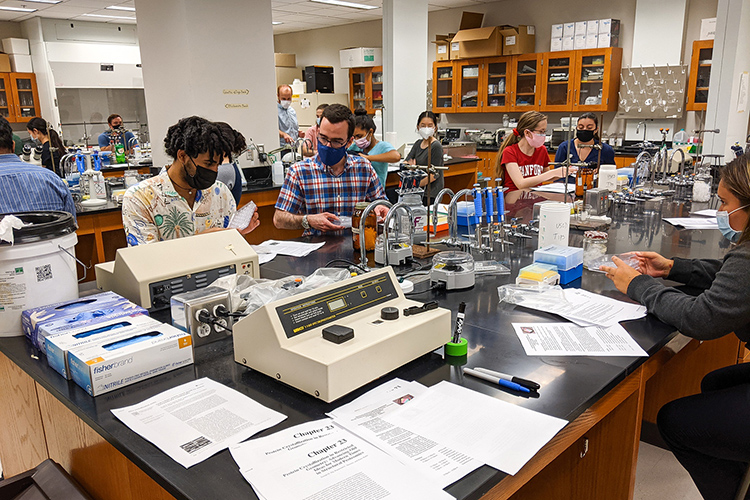
Middle Tennessee State University faculty and chemistry undergraduate students who earned the National Science Foundation Research Experience for Undergraduates grant participate in a workshop at the University of Alabama in Huntsville taught by UAH professor Joseph Ng on June 25, 2021. (Photo courtesy of Adrienne Friedli)
At UAH, students took a workshop with professor Joe Ng on bio molecule crystallization.
“The highlight of the visit was a crystallography workshop where students from MTSU and UAH grew protein crystals,” said Justin Miller, an MTSU assistant chemistry professor who collaborates with Ng.
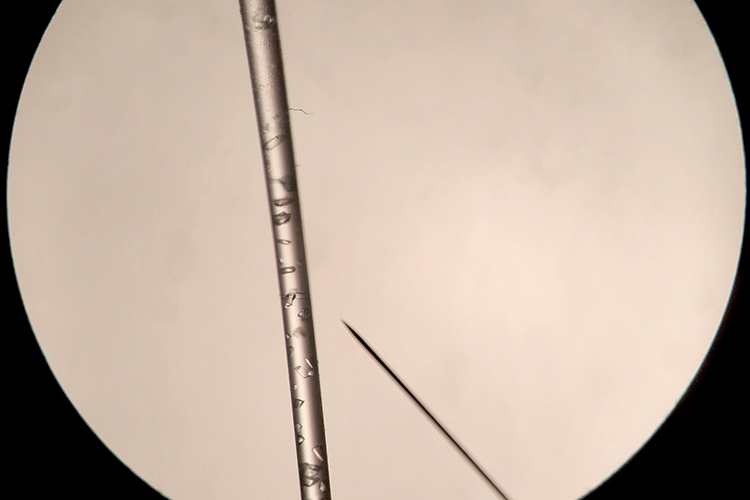
Undergraduate students from around the country who earned the National Science Foundation Research Experience for Undergraduates grant, hosted this summer by Middle Tennessee State University, participate in research about crystals like the lysosome protein grown as single crystals pictured here. (Photo courtesy of Joseph Ng)
CRUX students also participated in the celebration and presentation of their research at the close of the program and wrote up research reports in anticipation of scientific publication.
More undergraduate research opportunities
Leander recommends that MTSU undergraduates interested in research ask their professors about opportunities.
In addition, “Consider applying for an Undergraduate Research Experience and Creative Activity grant through the Center for Undergraduate Research,” she said. “Also the Office of Undergraduate Fellowships holds workshops every year on how to get involved in these kind of research opportunities, so we have a lot of good resources like that that students should look into.”

Alex LaVerde, left, from the University of Alabama in Tuscaloosa, Ala., and Jennifer Lopez from Ginnell College in Grinnell, Iowa, conduct research on acoustic ring resonance in MTSU’s Wiser-Patten Science building on July 28, 2021. The two were among a group of undergraduate students from around the country who earned the National Science Foundation Research Experience for Undergraduates grant and spent eight weeks at Middle Tennessee State University this summer for workshops, courses, travel, research and experiments. (MTSU photo by J. Intintoli)
To learn more about undergraduate research opportunities, visit the Undergraduate Research Center website and follow the center on Facebook.
— Stephanie Barrette (Stephanie.Barrette@mtsu.edu)

COMMENTS ARE OFF THIS POST